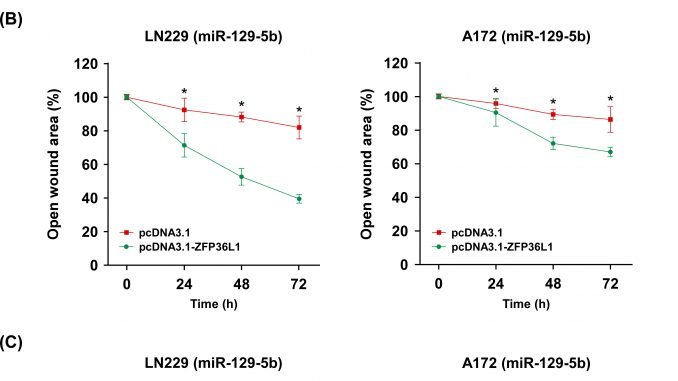
Glioblastoma multiforme is one of the most malignant tumors of the central nervous system. It is characterized by the fast growth and high malignancy. Although surgery combined with radiation therapy and chemotherapy has been widely used for the treatment of glioblastoma, the prognosis is still very poor. Furthermore, chemoresistance and radioresistance are the typical hallmarks of the recurrent glioblastoma. Thus, it is necessary to identify all the potential therapeutic targets for glioblastoma and to clarify its underlying mechanism.
In recent years, attention has been paid to the role of microRNAs in the development, diagnosis, and prognosis of gliomas. Thus, the team of researchers from the Cancer Hospital of China Medical University revealed that miR-129-5p, and ZFP36L1 gene were functionally involved in the hallmarks glioblastoma. This includes the tumor proliferation, migration, and tumor colony-forming abilities.
The level of miR-129-5p was significantly decreased in glioblastoma tissues and cell lines. In addition, ZFP36L1 expression in glioblastoma was negatively regulated by miR-129-5p and it was associated with poor survival. Forced expression of miR-129-5p suppressed the glioblastoma proliferation, migration, and colony-forming ability. Thus, this study, published in the journal BJBMS not only identified a new tumor suppressor role of miR-129-5p/ZFP36L1 axis in the tumorigenesis of glioblastoma, but also sheds a new light on further targeted therapy against malignant glioblastoma in the future.
Reference:
Guo X, Piao H, Zhang Y, Sun P, Yao B. Overexpression of microRNA-129-5p in glioblastoma inhibits cell proliferation, migration, and colony-forming ability by targeting ZFP36L1. Bosn J of Basic Med Sci. 2019. doi: 10.17305/bjbms.2019.4503.
Editor: Edna Skopljak
Leave a Reply